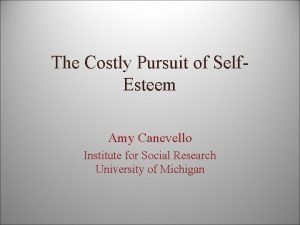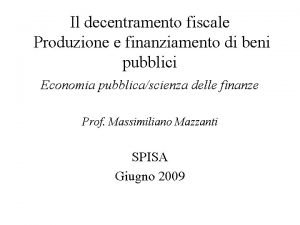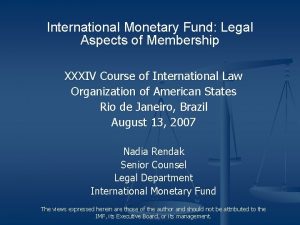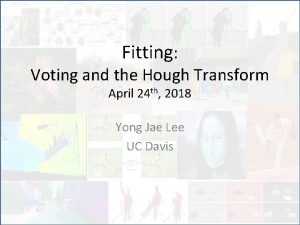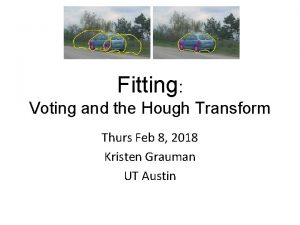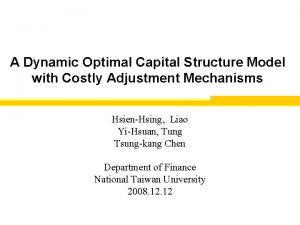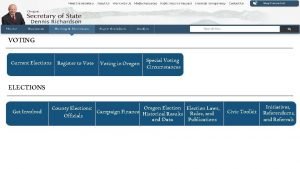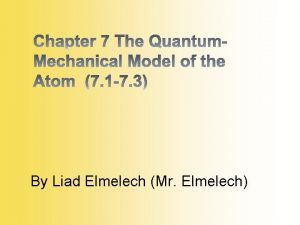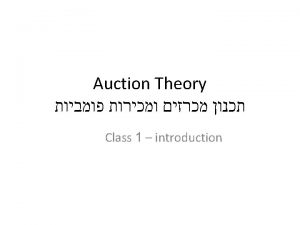Optimal FalseNameProof Voting Rules with Costly Voting Liad
















- Slides: 16

Optimal False-Name-Proof Voting Rules with Costly Voting Liad Wagman Vincent Conitzer Duke University Malvika Rao CS 286 r Class Presentation Harvard University

Overview • • • Introduction Definitions False-name-proof voting rule for 2 alternatives Group false-name-proofness False-name-proof voting rule for 3 alternatives Discussion

Introduction • Introducing costs… • Previous rules without costs unresponsive to agent preferences. • Idea: no one ever benefits by voting additional times. • Because we now have costs we are tying utility to money. So people’s utility function becomes comparable.

Definitions (2 alternatives) • Definition 1 (State): A state consists of a pair (x. A, x. B), where xj ≥ 0 is the # of votes for j in {A, B}. • Definition 2 (Voting Rule): A voting rule is a mapping from the set of states to the set of probability distributions over outcomes. The probability that alternative j in {A, B} is selected in state (x. A, x. B) is denoted by Pj(x. A, x. B). • Definition 3 (Neutrality): A voting rule is neutral if PA(x, y) = PB(y, x).

Definitions (2 alternatives) • Let ti. A and ti. B be the # of times agent i votes for A and B. If i prefers alternative j then i’s expected utility ui(x. A, x. B, ti. A, ti. B) = Pj(x. A + ti. A, x. B + ti. B) - (ti. A + ti. B - 1)c. • Definition 4 (Voluntary Participation): A voting rule satisfies voluntary participation if for an agent i who prefers A, for all (x. A, x. B), ui(x. A, x. B, 1, 0) ≥ ui(x. A, x. B, 0, 0). • Definition 5 (Strategy-proofness): A voting rule is strategyproof if for an agent i who prefers A, for all (x. A, x. B), ui(x. A, x. B, 1, 0) ≥ ui(x. A, x. B, 0, 1).

Definitions (2 alternatives) • Definition 6 (False-name-proofness): A voting rule is falsename-proof (with costs) if for an agent i who prefers A, for all (x. A, x. B), for all ti. A ≥ 1 and ti. B, ui(x. A, x. B, 1, 0) ≥ ui(x. A, x. B, ti. A, ti. B). • Definition 7 (Strong optimality): A neutral false-name-proof voting rule P that satisfies voluntary participation is strongly optimal if for any other such rule P´, for any state (x. A, x. B) where x. A ≥ x. B, we have PA(x. A, x. B) ≥ P´A(x. A, x. B).

False-name-proof voting rule for 2 alternatives • FNP 2: Suppose x. A ≥ x. B. Then PA(x. A, x. B) = 1 if x. A > x. B = 0, PA(x. A, x. B) = min{1, 1/2 + c(x. A - x. B)} if x. A ≥ x. B > 0 or x. A = x. B = 0. • Theorem: FNP 2 is the unique strongly optimal neutral false-name-proof voting rule with 2 alternatives that satisfies voluntary participation.

False-name-proof voting rule for 2 alternatives • Proof: FNP 2 is strongly optimal • By neutrality for any x ≥ 0 P´A(x, x) = 1/2. • By false-name-proofness for any x > 0 P´A(x+1, x) - P´A(x, x) ≤ c. So P´A(x+1, x) ≤ 1/2 + c. • Similarly P´A(x+2, x) ≤ P´A(x+1, x) + c ≤ 1/2 + 2 c. • For any t > 0 P´A(x+t, x) ≤ 1/2 + tc. • Since P´A(x+t, x) ≤ 1, P´A(x+t, x) ≤ min{1, 1/2 + tc}. • But PA(x+t, x) = min{1, 1/2 + tc}.

FNP 2 Responsiveness • Example: c = 0. 15. 5 4 3 2 1 0 x. B / x. A 0 0 0. 5 0 0 0. 05 0. 2 0. 35 0. 5 1 1 0. 05 0. 2 0. 35 0. 65 1 2 0. 35 0. 65 0. 8 1 3 0. 35 0. 65 0. 8 0. 95 1 4 0. 5 0. 65 0. 8 0. 95 1 1 5

FNP 2 Responsiveness • Convergence to majority winner as n --> ∞.

FNP 2 Responsiveness • Average probability that FNP 2 and majority rule disagree as a function of c.

FNP 2 Responsiveness • Average probability that FNP 2 and majority rule disagree as a function of p (probability agent prefers A).

Group false-name-proof voting rule for 2 alternatives • FNP 2 is not group false-name-proof. Consider the example: c = 0. 15, x. A = x. B = 2. If the 2 agents that prefer A each cast an additional vote then A now wins with probability 0. 8. Each agent is 0. 3 - 0. 15 = 0. 15 better off. • A rule is group false-name-proof (with costs and transfers) if for all k ≥ 1, for all (x. A, x. B), for all t. A ≥ k and t. B, PA(x. A + k, x. B) ≥ PA(x. A + t. A, x. B + t. B) - c(t. A + t. B - k)/k.

Group false-name-proof voting rule for 2 alternatives • Strongly optimal GFNP 2: Suppose x. A ≥ x. B. Then PA(x. A, x. B) = 1 if x. A > x. B = 0, PA(x. A, x. B) = 1/2 if x. A = x. B = 0, PA(x. A, x. B) = min{1, 1/2 + ∑k (c/k) for k = x. B to x. A-1} if x. A ≥ x. B > 0. • As n --> ∞ GFNP 2 yields the opposite result from the majority rule at least 40% of the time. There is no finite c such that GFNP 2 coincides with the majority rule.

False-name-proof voting rule for 3 alternatives • Strong optimality: Voting rule P is strongly optimal if for any other rule P´, for any (x. A, x. B , x. C) where x. A ≥ x. B ≥ x. C ≥ 1, either PA (x. A, x. B , x. C) > P´A (x. A, x. B , x. C); or PA (x. A, x. B , x. C) = P´A (x. A, x. B , x. C) and PB (x. A, x. B , x. C) ≥ P´B (x. A, x. B , x. C). • FNP 3: Suppose x. A ≥ x. B ≥ x. C ≥ 1. Then PA (x. A, x. B , x. C) = min{1, 1/2 + c(x. A - x. B) - 1/2 max{0, 1/3 c(x. B - x. C)}} PC (x. A, x. B , x. C) = max{0, 1/3 - c((x. A + x. B)/2 - x. C)} PB (x. A, x. B , x. C) = 1 - PA (x. A, x. B , x. C) - PC (x. A, x. B , x. C)

Discussion • • • 4+ alternatives… How can we improve group false-name-proofness? GFNP 3? Continuous preferences Bayes-Nash
 Liad blumrosen
Liad blumrosen Liad blumrosen
Liad blumrosen Degree of comparison of dry
Degree of comparison of dry Costly
Costly The costly pursuit of self-esteem
The costly pursuit of self-esteem Napoleon's costly mistakes
Napoleon's costly mistakes David wants to buy a christmas present for a very
David wants to buy a christmas present for a very Voting by feet tiebout
Voting by feet tiebout Red line voting
Red line voting Deployment diagram for online voting system
Deployment diagram for online voting system Deployment diagram notations
Deployment diagram notations Pros and cons of fptp
Pros and cons of fptp Imf voting power
Imf voting power Hough voting
Hough voting Hough voting
Hough voting Meetoo live polling
Meetoo live polling Brainpop voting
Brainpop voting




